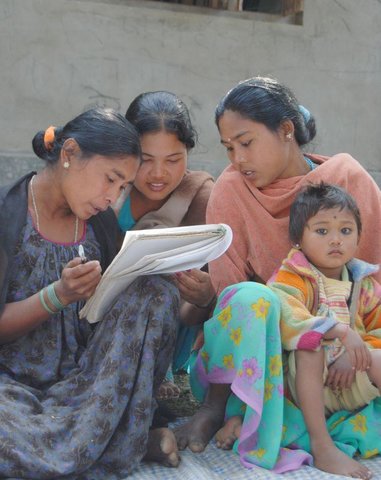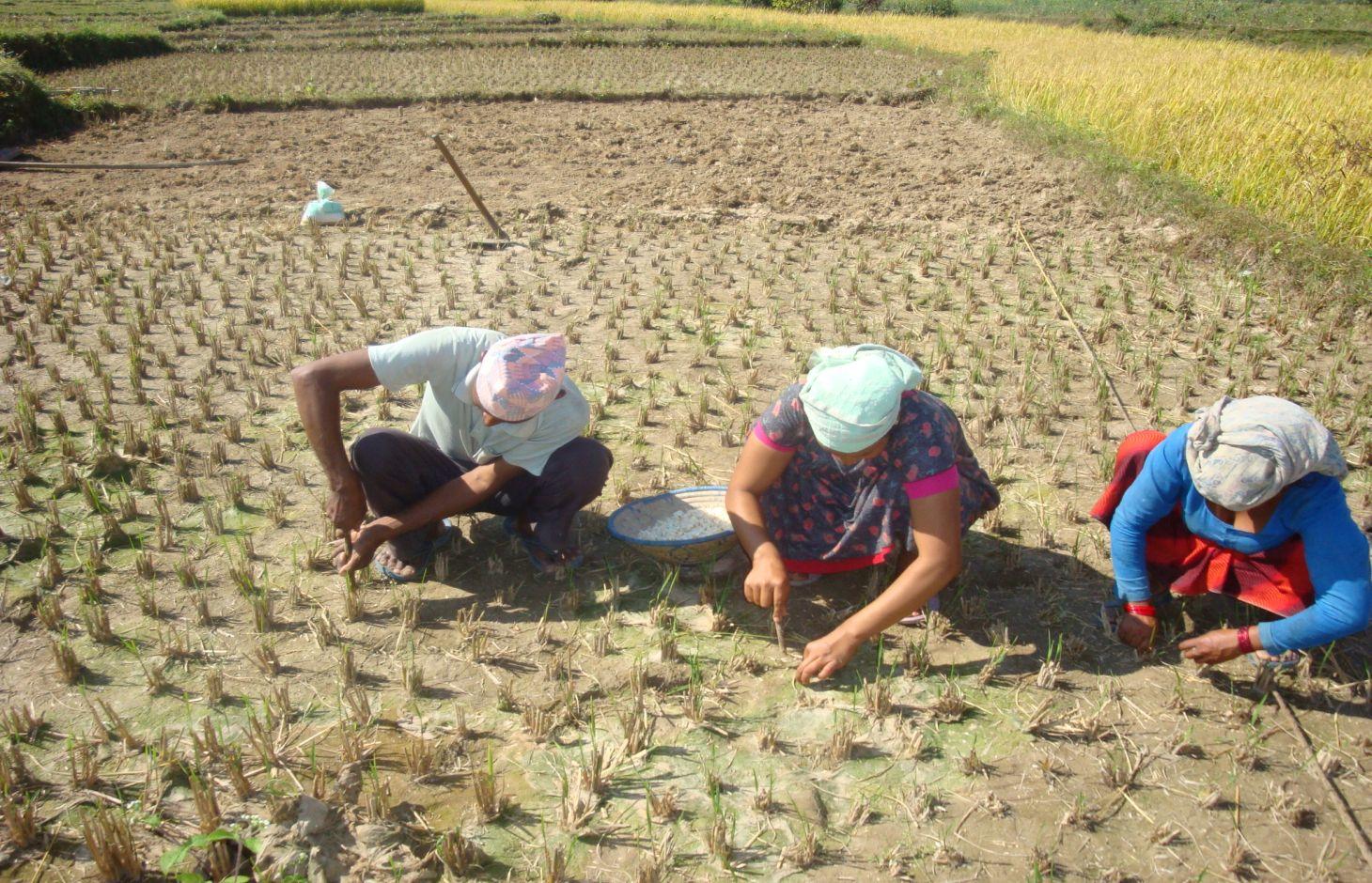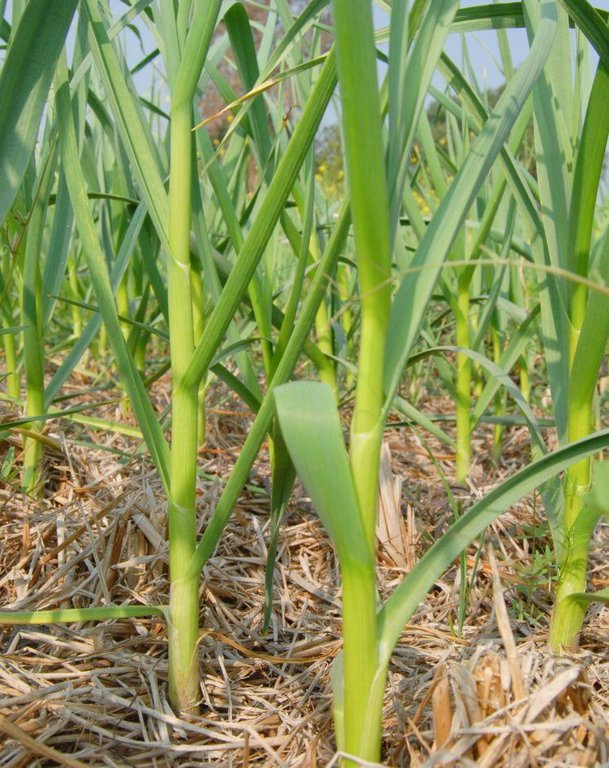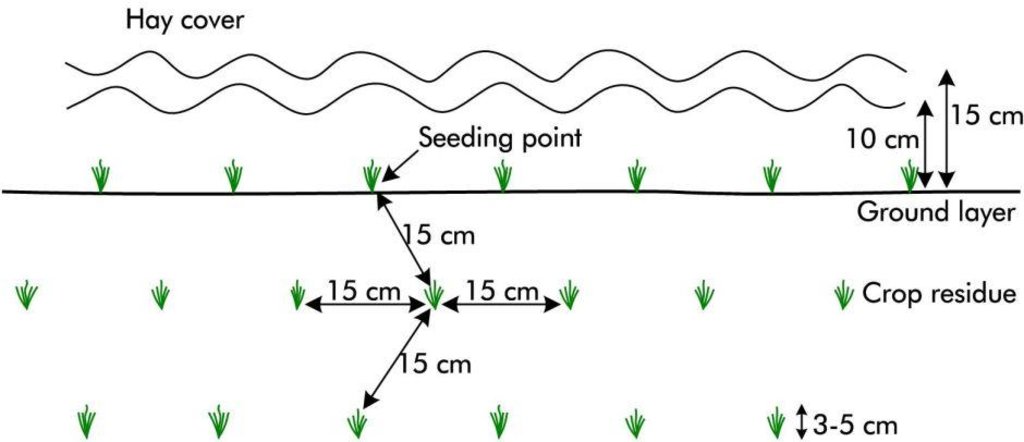No-till garlic cultivation [Nepal]
- Creation:
- Update:
- Compiler: Shreedip Sigdel
- Editor: –
- Reviewers: David Streiff, Alexandra Gavilano
Khan jot nagari lasun kheti (Main Contributor: Krishna Lamsal, LI-BIRD)
technologies_1276 - Nepal
View sections
Expand all Collapse all1. General information
1.2 Contact details of resource persons and institutions involved in the assessment and documentation of the Technology
SLM specialist:
Lamsal Krishna
LI-BIRD
Nepal
Name of the institution(s) which facilitated the documentation/ evaluation of the Technology (if relevant)
ICIMOD International Centre for Integrated Mountain Development (ICIMOD) - NepalName of the institution(s) which facilitated the documentation/ evaluation of the Technology (if relevant)
Local Initiatives for Biodiversity, Research, and Development (LI-BIRD) - Nepal1.3 Conditions regarding the use of data documented through WOCAT
The compiler and key resource person(s) accept the conditions regarding the use of data documented through WOCAT:
Yes
1.5 Reference to Questionnaire(s) on SLM Approaches (documented using WOCAT)

Learning about no-till methods through farmer-to-farmer dissemination [Nepal]
Farmer to farmer dissemination of information on no-till methods for garlic cultivation technology
- Compiler: Shreedip Sigdel
2. Description of the SLM Technology
2.1 Short description of the Technology
Definition of the Technology:
No-till is a farming system in which the seeds are planted directly into untilled soil which still contains the previous crop residues. No-till cultivation of garlic is practiced in the tropical lowland districts of western Nepal where garlic is sown directly into the soil after the paddy is harvested.
2.2 Detailed description of the Technology
Description:
No-till* methods minimize soil disturbance and allow crop residues or stubble to remain on the ground instead of being removed or dug into the soil. As practised in the western Terai of Nepal, the seedbed is prepared by leaving a 3–5 cm thick layer of rice paddy crop residue on the soil surface after the paddy harvest. Garlic seed is planted directly into the soil soon after the paddy is harvested at a spacing of approximately 15 cm and the entire field is then covered with a 10 cm (or more) layer of hay. The seeds germinate with the help of the ambient moisture. The frequency and timing of irrigation depends on need, but since there has been no tillage and the ground is covered with mulch, much of the ambient moisture is retained in the soil. The mature garlic is harvested in February–March. This technology is gaining in popularity because farmers can directly see the economic benefit of not having to till the soil.
Purpose of the Technology: No-till methods are important from the standpoint of environmental farming for a number of reasons. The fact that the soil is not tilled after the paddy is harvested and remains covered with crop residues leads to efficient erosion control (up to 90%) and increased biological activity in and on the soil. The technology helps to conserve moisture in the soil, to improve the infiltration of water (up to 60%), and to reduce soil compaction, and overall, it requires less energy for cultivation (Derpsch et al. 2010). Increasing soil organic matter also helps to sequester carbon and contributes to reducing agricultural greenhouse gas emissions; ultimately, it supports increased production and resilience to climate change. In addition to keeping carbon in the soil, in a recent study, no-till farming was found to reduce nitrous oxide (N2O) emissions by 40–70%, depending on the rotation.
Establishment / maintenance activities and inputs: * No-till in this context means the soil is not tilled after the paddy is harvested and before the garlic seeds are planted. After the garlic is harvested, the soil is tilled before the next crop is planted. No-till is a form of conservation tillage, which refers to methods that leave at least 30% of crop residues in place.
2.3 Photos of the Technology
2.5 Country/ region/ locations where the Technology has been applied and which are covered by this assessment
Country:
Nepal
Further specification of location:
Kailali district
Specify the spread of the Technology:
- evenly spread over an area
If precise area is not known, indicate approximate area covered:
- 1-10 km2
2.6 Date of implementation
If precise year is not known, indicate approximate date:
- less than 10 years ago (recently)
2.7 Introduction of the Technology
Specify how the Technology was introduced:
- through land users' innovation
3. Classification of the SLM Technology
3.1 Main purpose(s) of the Technology
- reduce, prevent, restore land degradation
3.2 Current land use type(s) where the Technology is applied

Cropland
- Annual cropping
Number of growing seasons per year:
- 3
Specify:
Longest growing period in days: 240; Longest growing period from month to month: March - October; Second longest growing period in days: 100; Second longest growing period from month to month: November-January
Comments:
Future (final) land use (after implementation of SLM Technology): Cropland: Ca: Annual cropping
3.3 Has land use changed due to the implementation of the Technology?
Has land use changed due to the implementation of the Technology?
- No (Continue with question 3.4)
3.4 Water supply
Water supply for the land on which the Technology is applied:
- mixed rainfed-irrigated
3.5 SLM group to which the Technology belongs
- minimal soil disturbance
3.6 SLM measures comprising the Technology

agronomic measures
- A3: Soil surface treatment
A3: Differentiate tillage systems:
A 3.1: No tillage
Comments:
Main measures: agronomic measures
Specification of other agronomic measures: no-till
Type of agronomic measures: zero tillage / no-till
3.7 Main types of land degradation addressed by the Technology

soil erosion by water
- Wt: loss of topsoil/ surface erosion
Comments:
Main type of degradation addressed: Wt: loss of topsoil / surface erosion
Main causes of degradation: soil management (poor soil management), change in temperature, change of seasonal rainfall
3.8 Prevention, reduction, or restoration of land degradation
Specify the goal of the Technology with regard to land degradation:
- reduce land degradation
4. Technical specifications, implementation activities, inputs, and costs
4.1 Technical drawing of the Technology
Technical specifications (related to technical drawing):
No-till garlic cultivation in fields where paddy has just been harvested.
Technical knowledge required for field staff / advisors: high
Technical knowledge required for land users: high
Main technical functions: increase in organic matter, increase in nutrient availability (supply, recycling,…)
Secondary technical functions: increase of infiltration, increase / maintain water stored in soil
Author:
Krishna Lamsal, AK Thaku
4.2 General information regarding the calculation of inputs and costs
Specify how costs and inputs were calculated:
- per Technology area
Indicate size and area unit:
ha
Specify currency used for cost calculations:
- USD
Indicate average wage cost of hired labour per day:
4.20
4.5 Maintenance/ recurrent activities
| Activity | Timing/ frequency | |
|---|---|---|
| 1. | maintenance and recurrent activities are minimal. The seedling need to be watered, fertilized and weeded | October-March |
4.6 Costs and inputs needed for maintenance/ recurrent activities (per year)
| Specify input | Unit | Quantity | Costs per Unit | Total costs per input | % of costs borne by land users | |
|---|---|---|---|---|---|---|
| Labour | Maintenance | Persons/ha | 6.0 | 4.23333333 | 25.4 | 100.0 |
| Plant material | Seeds | kg/ha | 10.0 | 0.7 | 7.0 | 100.0 |
| Fertilizers and biocides | Fertilizer | kg/ha | 1.0 | 0.7 | 0.7 | 100.0 |
| Fertilizers and biocides | Compost / manure | kg/ha | 200.0 | 0.014 | 2.8 | 100.0 |
| Other | Mulch | kg/ha | 60.0 | 0.23333333 | 14.0 | 100.0 |
| Other | Irrigation | ha | 1.0 | 1.4 | 1.4 | 100.0 |
| Total costs for maintenance of the Technology | 51.3 | |||||
| Total costs for maintenance of the Technology in USD | 51.3 | |||||
5. Natural and human environment
5.1 Climate
Annual rainfall
- < 250 mm
- 251-500 mm
- 501-750 mm
- 751-1,000 mm
- 1,001-1,500 mm
- 1,501-2,000 mm
- 2,001-3,000 mm
- 3,001-4,000 mm
- > 4,000 mm
Agro-climatic zone
- sub-humid
Thermal climate class: subtropics
5.2 Topography
Slopes on average:
- flat (0-2%)
- gentle (3-5%)
- moderate (6-10%)
- rolling (11-15%)
- hilly (16-30%)
- steep (31-60%)
- very steep (>60%)
Landforms:
- plateau/plains
- ridges
- mountain slopes
- hill slopes
- footslopes
- valley floors
Altitudinal zone:
- 0-100 m a.s.l.
- 101-500 m a.s.l.
- 501-1,000 m a.s.l.
- 1,001-1,500 m a.s.l.
- 1,501-2,000 m a.s.l.
- 2,001-2,500 m a.s.l.
- 2,501-3,000 m a.s.l.
- 3,001-4,000 m a.s.l.
- > 4,000 m a.s.l.
5.3 Soils
Soil depth on average:
- very shallow (0-20 cm)
- shallow (21-50 cm)
- moderately deep (51-80 cm)
- deep (81-120 cm)
- very deep (> 120 cm)
Soil texture (topsoil):
- fine/ heavy (clay)
Topsoil organic matter:
- high (>3%)
If available, attach full soil description or specify the available information, e.g. soil type, soil PH/ acidity, Cation Exchange Capacity, nitrogen, salinity etc.
Soil fertility is high
Soil drainage / infiltration is medium
Soil water storage capacity is high
5.4 Water availability and quality
Ground water table:
5-50 m
Availability of surface water:
poor/ none
Water quality (untreated):
poor drinking water (treatment required)
Comments and further specifications on water quality and quantity:
Water quality (untreated): ALso for agricultural use only (irrigation)
5.5 Biodiversity
Species diversity:
- low
5.6 Characteristics of land users applying the Technology
Market orientation of production system:
- mixed (subsistence/ commercial)
Off-farm income:
- 10-50% of all income
Relative level of wealth:
- poor
- average
Individuals or groups:
- individual/ household
Level of mechanization:
- manual work
- animal traction
Gender:
- women
- men
Indicate other relevant characteristics of the land users:
Land users applying the Technology are mainly common / average land users
Population density: > 500 persons/km2
Annual population growth: 2% - 3%
80% of the land users are average wealthy.
5% of the land users are poor.
Level of mechanization: Also mechanized
5.7 Average area of land used by land users applying the Technology
- < 0.5 ha
- 0.5-1 ha
- 1-2 ha
- 2-5 ha
- 5-15 ha
- 15-50 ha
- 50-100 ha
- 100-500 ha
- 500-1,000 ha
- 1,000-10,000 ha
- > 10,000 ha
Is this considered small-, medium- or large-scale (referring to local context)?
- small-scale
5.8 Land ownership, land use rights, and water use rights
Land ownership:
- individual, not titled
Land use rights:
- individual
Water use rights:
- communal (organized)
6. Impacts and concluding statements
6.1 On-site impacts the Technology has shown
Socio-economic impacts
Production
crop production
risk of production failure
Comments/ specify:
because moisture in retained
Income and costs
diversity of income sources
Comments/ specify:
powdered garlic is considered cash crop as it has medicinal values
workload
Other socio-economic impacts
labour cost
Socio-cultural impacts
SLM/ land degradation knowledge
livelihood and human well-being
Comments/ specify:
Increased farm income, reduce risk of crop production failure, reduced work load
Ecological impacts
Soil
soil moisture
soil loss
nutrient cycling/ recharge
Climate and disaster risk reduction
emission of carbon and greenhouse gases
6.3 Exposure and sensitivity of the Technology to gradual climate change and climate-related extremes/ disasters (as perceived by land users)
Gradual climate change
Gradual climate change
| Season | increase or decrease | How does the Technology cope with it? | |
|---|---|---|---|
| annual temperature | increase | not well |
Climate-related extremes (disasters)
Meteorological disasters
| How does the Technology cope with it? | |
|---|---|
| local rainstorm | not well |
| local windstorm | not well |
Climatological disasters
| How does the Technology cope with it? | |
|---|---|
| drought | not well |
Hydrological disasters
| How does the Technology cope with it? | |
|---|---|
| general (river) flood | not well |
Comments:
can be made adaptive to the changing context by using improved varieties of seed which are resistant (tolerant) to environmental stresses like drought, increase in temperature or heavy precipitation
6.4 Cost-benefit analysis
How do the benefits compare with the maintenance/ recurrent costs (from land users' perspective)?
Short-term returns:
positive
Long-term returns:
positive
6.5 Adoption of the Technology
Of all those who have adopted the Technology, how many did so spontaneously, i.e. without receiving any material incentives/ payments?
- 91-100%
Comments:
100% of land user families have adopted the Technology without any external material support
Comments on spontaneous adoption: This technology is widely adopted and practiced by a large percentage of household. All the household who practice this technology do so at their own cost.
There is a strong trend towards spontaneous adoption of the Technology
Comments on adoption trend: This technology has become popular among neighboring communities and districts.
6.7 Strengths/ advantages/ opportunities of the Technology
| Strengths/ advantages/ opportunities in the compiler’s or other key resource person’s view |
|---|
|
Decreased soil erosion, diversification of income source and livelihood options; reduced expenses on agricultural input How can they be sustained / enhanced? Water needs to be available for irrigation and market linkages are needed to be able to fully profit from this cash crop |
|
Soil conservation, improves water infiltration, increase organic matter in the soil; save effort and time How can they be sustained / enhanced? more awareness of the conservation value of no-till methods |
|
Carbon sequestration reduced agricultural greenhouse gas emission and climate change adaptation How can they be sustained / enhanced? improved varieties of garlic that have stress resistance characteristics would help adaptation to climate change and would enhance environmental benefit |
7. References and links
7.1 Methods/ sources of information
7.2 References to available publications
Title, author, year, ISBN:
Current status of adoption of no-till farming in the world and some of its main benefits,Derpsch,R;Friedrich,T;Hongwen,L;, 2010
Available from where? Costs?
www.fao.org/ag/ca/CA-Publications/China_IJABE.pdf
Links and modules
Expand all Collapse allLinks

Learning about no-till methods through farmer-to-farmer dissemination [Nepal]
Farmer to farmer dissemination of information on no-till methods for garlic cultivation technology
- Compiler: Shreedip Sigdel
Modules
No modules





